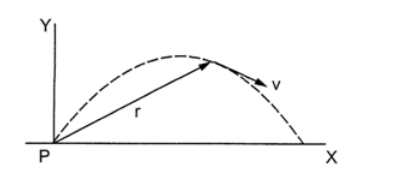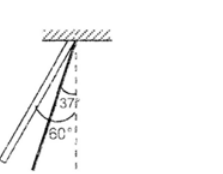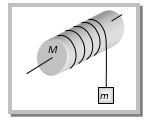12th Grade > Physics
ROTATION ROCK AND ROLL MCQs
Total Questions : 30
| Page 3 of 3 pages
Answer: Option B. -> √43gh
:
B
Velocity at the bottom (v)=√2gh1+K2R2=√2gh1+12=√43gh.
:
B
Velocity at the bottom (v)=√2gh1+K2R2=√2gh1+12=√43gh.
Question 22. A small meteorite of mass 'm' travelling towards the centre of earth strikes the earth at the equator. The earth is a uniform sphere of mass 'M' and radius 'R'. The length of the day was 'T' before the meteorite struck. After the meteorite strikes the earth, the length of day increases (in sec) by
Answer: Option A. -> 5mT2M
:
A
I1ω1=I2ω2
25MR2×(2πT1)=(25MR2+mR2)2πT2
T2T1=1+5m2M
T2−T1T1=5m2M
T2−T1=5mT2M [i.e;T1=T]
:
A
I1ω1=I2ω2
25MR2×(2πT1)=(25MR2+mR2)2πT2
T2T1=1+5m2M
T2−T1T1=5m2M
T2−T1=5mT2M [i.e;T1=T]
Answer: Option C. -> g4
:
C
a=gsinθ1+k2R2=gsin30∘1+1=g4 [Ask2R2=1andθ=30∘]
:
C
a=gsinθ1+k2R2=gsin30∘1+1=g4 [Ask2R2=1andθ=30∘]
Answer: Option B. -> √34gl sinθ
:
B
Let the mass of the cylinder be m and its radius r. Suppose the linear speed of the cylinder when it reaches the bottom is v. As the cylinder rolls without slipping, its angular speed about its axis is ω=vr. The kinetic energy at the bottom will be= 34mv2
Note: Try reducing this result on your own for practice.
Thus, 34mv2=mglsinθ
or, v=√43glsinθ
:
B
Let the mass of the cylinder be m and its radius r. Suppose the linear speed of the cylinder when it reaches the bottom is v. As the cylinder rolls without slipping, its angular speed about its axis is ω=vr. The kinetic energy at the bottom will be= 34mv2
Note: Try reducing this result on your own for practice.
Thus, 34mv2=mglsinθ
or, v=√43glsinθ
Answer: Option B. -> mv302√2g^(−j)
:
B
Let us take the origin at P, X-axis along the horizontal and Y-axis along the vertically upwards direction as shown in figure. For the horizontal motion during the time 0 to t,

vx=v0cos45∘=v0√2
and x=vxt=v0√2.v0g=v20√2g
For vertical motion,
vγ=v0sin45∘−gt=v0√2−v0=1−√2√2v0
and y=(v0sin45∘)t−12gt2
y=v20√2g−v202g=v202g(√2−1)
The angular momentum of the particle at time t about the origin is
L=⃗r×⃗p=m⃗r×⃗v
=m(→ix+→jy)×(−→ivx+−→jvy)
=m(⃗kxvy−→kyvx)
=m⃗k[(v20√2g)v0√2(1−√2)−v202g(√2−1)v0√2]
=−⃗kmv302√2g
Thus, the angular momentum of the particle is mv302√2g in the negative Z-direction, i.e., perpendicular to the plane of motion, going into the plane.
:
B
Let us take the origin at P, X-axis along the horizontal and Y-axis along the vertically upwards direction as shown in figure. For the horizontal motion during the time 0 to t,

vx=v0cos45∘=v0√2
and x=vxt=v0√2.v0g=v20√2g
For vertical motion,
vγ=v0sin45∘−gt=v0√2−v0=1−√2√2v0
and y=(v0sin45∘)t−12gt2
y=v20√2g−v202g=v202g(√2−1)
The angular momentum of the particle at time t about the origin is
L=⃗r×⃗p=m⃗r×⃗v
=m(→ix+→jy)×(−→ivx+−→jvy)
=m(⃗kxvy−→kyvx)
=m⃗k[(v20√2g)v0√2(1−√2)−v202g(√2−1)v0√2]
=−⃗kmv302√2g
Thus, the angular momentum of the particle is mv302√2g in the negative Z-direction, i.e., perpendicular to the plane of motion, going into the plane.
Answer: Option C. -> 0.9√2(dm)g
:
C
Let I = length of the rod, and m = mass of the rod.
Applying energy principle

(12)lω2−O=mg(12)(cos37∘−cos60∘)
⇒12×ml23ω2=mg×12(45−12)
⇒ω2=9g10l=0.9(gl)
Again (m23)∝=mg(12)sin37∘=mgl2×35
∴α=0.9(gl)= angular acceleration.
So, to find out the force on the particle at the tip of the rod
F1−centrifugal force=(dm) ω2l=0.9(dm)g
Ft−tangential force=(dm) ωl=0.9(dm)g
So, total force F=√(F21+F2t)=0.9√2(dm)g
:
C
Let I = length of the rod, and m = mass of the rod.
Applying energy principle

(12)lω2−O=mg(12)(cos37∘−cos60∘)
⇒12×ml23ω2=mg×12(45−12)
⇒ω2=9g10l=0.9(gl)
Again (m23)∝=mg(12)sin37∘=mgl2×35
∴α=0.9(gl)= angular acceleration.
So, to find out the force on the particle at the tip of the rod
F1−centrifugal force=(dm) ω2l=0.9(dm)g
Ft−tangential force=(dm) ωl=0.9(dm)g
So, total force F=√(F21+F2t)=0.9√2(dm)g
Answer: Option D. -> √14:√15
:
D
Time of descent t=1sinθ√2hg(1+k2R2)∴Ratio=
⎷(1+k2R2)sphere(1+k2R2)disc=√1+251+12=√75×23=√1415
:
D
Time of descent t=1sinθ√2hg(1+k2R2)∴Ratio=
⎷(1+k2R2)sphere(1+k2R2)disc=√1+251+12=√75×23=√1415
Answer: Option A. -> 3v4a
:
A
Conserving Angular momentum before and after collision
mv×a2=Iω
Now, I=m(√2a)212+m(a√2)2
=ma2(16+12)
=23ma2.
∴ω=mva2×32ma2=3v4a.
:
A
Conserving Angular momentum before and after collision
mv×a2=Iω
Now, I=m(√2a)212+m(a√2)2
=ma2(16+12)
=23ma2.
∴ω=mva2×32ma2=3v4a.
Question 30. Moment of inertia of uniform rod of mass 'M' and length 'L' about an axis through its centre and perpendicular to its length is given by ML212. Now consider one such rod pivoted at its centre, free to rotate in a vertical plane. The rod is at rest in the vertical position. A bullet of mass 'M' moving horizontally at a speed 'v' strikes and embedded in one end of the rod. The angular velocity of the rod just after the collision will be



















